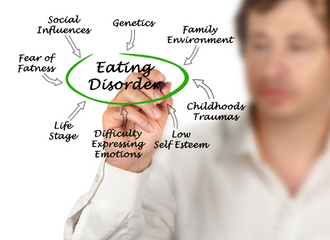Written by: Maggie Hartman, LMHC
Site Director at The Renfrew Center of New York City
Eating disorders in teenagers are serious, complex conditions that include a pattern of eating behaviors that negatively impact an individuals’ health, emotions, and ability to function across settings including school, work, and relationships. In this post we review the common types of eating disorders, eating disorders in the adolescent population, early warning signs, and next steps for those in which these signs have been identified.
Types of Eating Disorders
The most common eating disorders are anorexia nervosa, bulimia nervosa and binge eating disorder. Individuals with anorexia nervosa purposefully restrict their intake, which leads to low body weight. They experience an intense fear of weight gain and have poor body image. Some may engage in fasting or purging behaviors to lose weight.
Individuals with bulimia nervosa engage in binge eating episodes, which include consuming a very large amount of food in a discrete period of time and feeling a loss of control while eating. They then do things to compensate for the binge eating episode. For example, they may vomit, exercise, and/or use laxatives or diuretics, to prevent weight gain. They also judge themselves based on body size and appearance.
People with binge eating disorder also engage in binge eating episodes. They might eat large amounts even when not hungry, eat at a rapid pace, eat secretly, and feel upset, disgusted, or guilty after an episode. Unlike bulimia, they do not compensate for the food intake by engaging in purging behavior.
Finally, Other Specified Feeding or Eating Disorder (OSFED) is a diagnosis given to those who do not meet the strict diagnostic criteria for AN, BN, or BED, but report behaviors and symptoms severe enough to cause impairment.
Teenagers and Eating Disorders
Eating disorders often develop in the teen and young adult years, though can develop at any age, and are more common in females. There is no one exact cause, but rather a combination of biological, psychological, and environmental factors. Risk factors that are more common to teenagers, which may help explain the higher amount of eating disorder onset in this age group, include:
Biological
- Genetic or familial factors, for example research indicates that eating disorders along with other mental health conditions tend to run in families.
- Puberty, which promotes an increase in hormones, leading to physical, psychological, and emotional changes, including visible changes in body size and shape. Changes in weight are a natural and healthy part of development, though can create discomfort for teenagers and make them more vulnerable to appearance related comments. This is especially true if developing faster or slower than their peers.
Psychological
- Psychiatric co-morbidities such as depression, anxiety, OCD, ADHD, or trauma.
- Negative body image, gender dysphoria, low self-esteem, perfectionism, impulsivity, and/or difficulty expressing and regulating emotions.
Social or Environmental
- Major life changes such as a parent separation or loss of significant other, or the accumulation of many minor stressors. In addition, social isolation due to COVID restrictions.
- Parent or role model who diets or is unhappy with their body.
- High expectations from family/others, real or imagined, and the perception that they must be met.
- Social media use with a focus on comparing appearances and social statuses.
- Peer pressure or influences.
- Discrimination, oppression, and bullying that targets appearance, weight, race, and/or sexuality can be particularly hurtful to teenagers, an age group that looks for social conformity and belonging.
- Involvement in sports that focus on appearance or weight, such as gymnastics, dance/ballet, wrestling, track/cross country running, and swimming.
- Food insecurity or a history of food insecurity in the family’s history.
Warning Signs to Look Out For
Eating disorders are dangerous, and so it is important to recognize the early warning signs and symptoms. They include:
- Fluctuations in weight
- Obsessing over food/calories, body size and shape, and exercise
- Developing and adhering rigidly to specific food or exercise rules, routines, and rituals
- Disappearing after meals
- Eliminating foods or decreasing food variety
- Hiding or hoarding food
- Eating in secret/isolation
- Eating more/less than usual, or at a slower or faster pace
- Engaging in a lot of baking or cooking, generally to be enjoyed by others
- Isolating; withdrawing from friends and activities
- Menstrual irregularities
- Other physiological signs including cold hands/swollen feet; dehydration; dry skin/hair; discoloration of teeth or cavities; impaired immune function; swelling around salivary glands; difficulty concentrating; fainting; GI complaints; and sleep disturbances
Next Steps: What You Can Do to Help Your Teen
Full recovery is possible with proper identification and effective care, and early detection leads to better treatment outcomes. If you suspect your teen has an eating disorder, or has exhibited some of the early warning signs, talk to them, express your concerns directly and calmly, and without judgment.
Trust your instincts
You may be more aware that this is a problem than they are, or that they are willing to admit. It is helpful to consult with/get the opinions and recommendations from other professionals including teachers, counselors, and pediatricians.
Understand your treatment options
Eating disorders are complicated and require multi-disciplinary teams including pediatricians, psychiatrists, therapists, family therapists, and dietitians, whether that be at an outpatient level or within a higher level of care setting. A proper care team will be helpful in informing your treatment decisions.
Get support for yourself
You may have feelings of confusion and guilt, or find yourself generally overwhelmed, which is normal and to be expected when discovering something serious has developed in your loved one. If unmanaged, those feelings can interfere with your ability to focus your energy on what needs to happen to get your child well. Seeking support for yourself will not only allow for your own healing but will serve as a model for your teen and likely benefit the family system as whole.
Conclusion
Eating disorders are serious, potentially fatal illnesses that tend to develop in adolescence, and their most common clinical forms include anorexia nervosa, bulimia nervosa, binge eating disorder and OSFED (other specified feeding or eating disorder). There is no one exact cause of an eating disorder and as with many conditions, the more risk factors an individual has, the greater their vulnerability. Eating disorders often present with signs and symptoms, some of which are easily observable and may alert you to a potential problem or greater need, however the subtler signs can be harder to detect. Learning about all the warning signs can increase the chances of catching it early and treating it at the appropriate level of care. Eating disorder recovery is possible, and with an evidenced based approach and an interdisciplinary treatment team the better the outcome.




